Dissecting the Technology of ‘The Martian’: Water
This is the first in a short series that will examine a few of these real-life space systems that are referenced in The Martian.
Andy Weir’s novel The Martian has struck a chord with an audience of readers that extends far beyond the traditional sci-fi demographic. I think that part of the book’s broad popularity stems from the fact that Weir never leaps too far ahead of the current human condition. This makes his storyline approachable for readers who would normally dismiss the sci-fi genre as too fantastical, myself included.
Much of what grounds the story is the technology that is referenced throughout. There are no Zenon alien zappers or antimatter toothbrushes. In fact, many of the systems found on Weir’s imaginary Martian outpost are actually in use on the International Space Station (ISS) today. Weir sometimes extrapolates the capabilities of these systems into the future, but he invariably remains faithful to the science at their core.
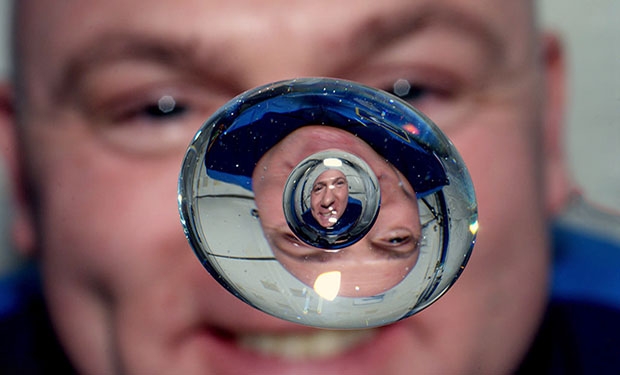
This is the first in a short series that will examine a few of these real-life space systems that are referenced in The Martian. The intent is not to compare any differences between the actual components and Weir’s versions. What would be the point? Although he aimed for (and largely achieved) technical accuracy, Weir had creative license to write about death rays powered by peanut butter if he chose. So there’s no point in splitting hairs. Rather, the goal here is simply to provide greater insight into the life-sustaining systems that that are referenced in the book and relied upon by astronauts and cosmonauts every day.
Today, we’ll discuss the use and recycling of water in manned space missions.
Reduce, Reuse, Recycle – Water on the ISS
I don’t want to divulge any spoilers to those of you who have not yet read the book. But I think it’s safe to say that water plays an important role in the plot of The Martian. Numerous events evolve from the main character’s use of the limited water he has available. That’s not to mention the extreme risks that he takes to manufacture additional gallons of the life-giving liquid.
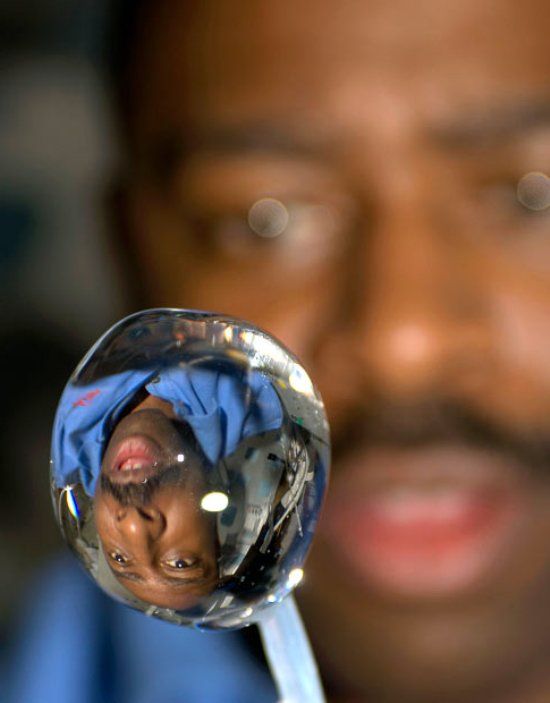
In real life, water is always an important consideration on the ISS. Those pesky astronauts living in orbit demand the stuff. Unfortunately, water is also heavy, and thus, costly to launch into space. The water needs of the six souls on board could place a crippling burden on the perpetually overbooked resupply missions. Even if a stash of water is on a cargo manifest, it may never be delivered to the ISS…as evidenced by the recent crash of a Falcon 9 rocket (unfortunately, one of three supply ship failures in the past year). This situation creates a huge incentive to maximize the use (and reuse) of the ISS’s limited water supply.
Furthermore, any manned missions that venture beyond Earth orbit will have even fewer options for resupply. It may be that the only provisions issued to a Mars-bound crew are those that it can carry. In any scenario, the lessons of water conservancy and efficiency that are being gleaned today on the ISS are vital to our ambition of someday having life imitate Weir’s literary art (well, except for the whole “stranded on Mars” part).
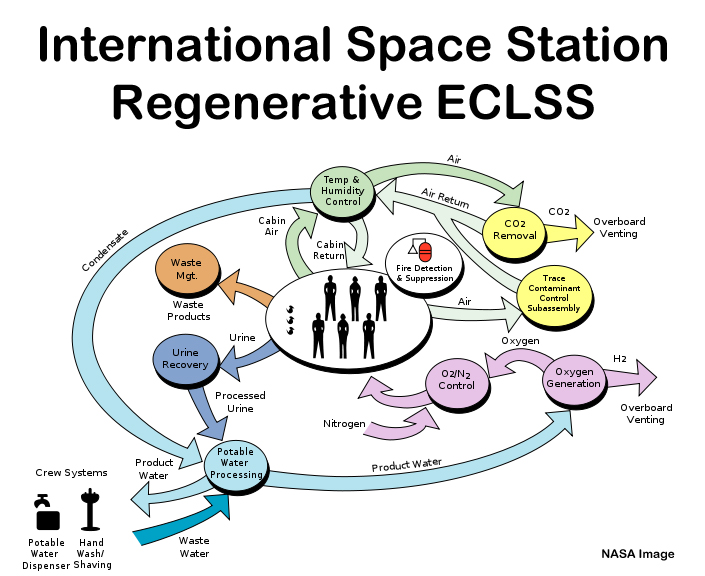
There are several water systems on the ISS of both US and Russian origins. Today, I’ll focus on the two systems which are the prime water sources for US segments of the ISS, the Urine Processor Assembly (UPA) and Water Processor Assembly (WPA). A 6-person ISS crew requires about 15,000 pounds of potable water each year. The UPA and WPA work in unison to meet a significant portion of that demand. The complete US water regeneration system typically achieves a 75% return rate.
Yesterday’s Coffee is Tomorrow’s Coffee
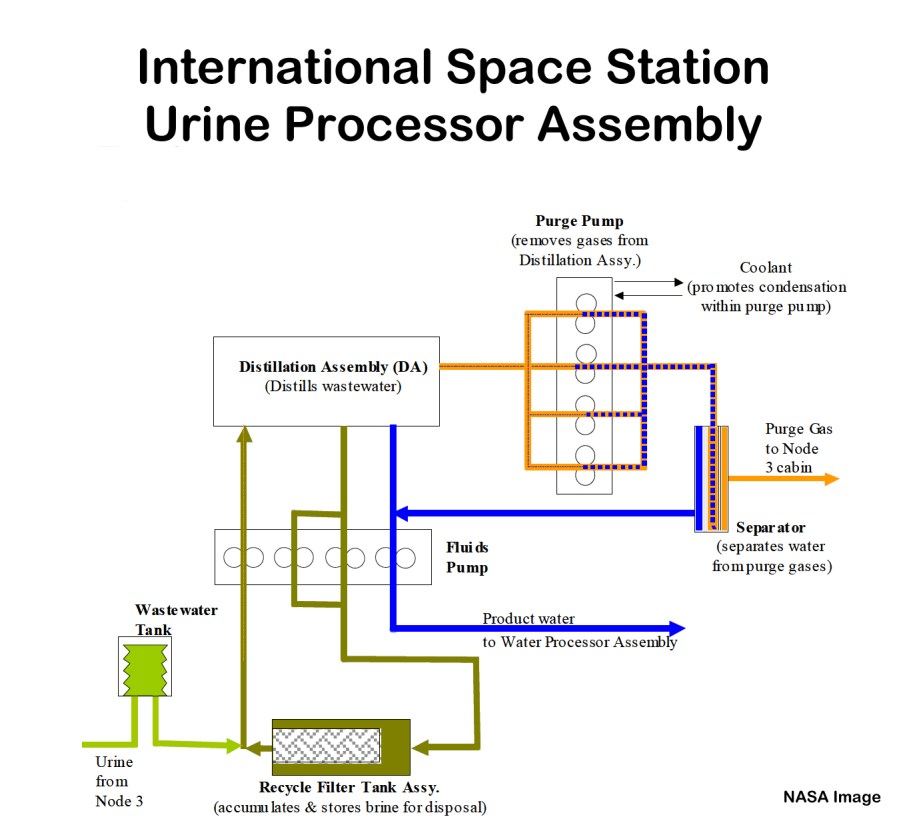
The UPA does exactly what you would expect. It takes stored urine and begins the process of making it safe to drink again. You might think that astronauts would have mental hang-ups over drinking from a water fountain that is fed by a urinal…no matter how magical the pixie dust that is sprinkled in between. Yet, when I asked Expedition 34/35 crewmember Thomas Marshburn about this, he replied that it was never an issue for him. He also confirmed that the processed water has no particular taste or odor.
Urine and the water used to flush it are stored in the Wastewater Storage Tank Assembly (WSTA). The smelly cocktail is pretreated with a combination of chromium trioxide and sulfuric acid. These chemicals keep microbial growth in check.
The fluid is pumped from the WSTA to the UPA. The core of UPA treatment revolves around the Distillation Assembly (DA)–literally. The entire DA spins at about 200rpm to compensate for the lack of gravity. Inside the DA, the pressure is reduced below 1psi, where vacuum distillation separates the fluid into water vapor and a brine containing most of the undesirable parts.
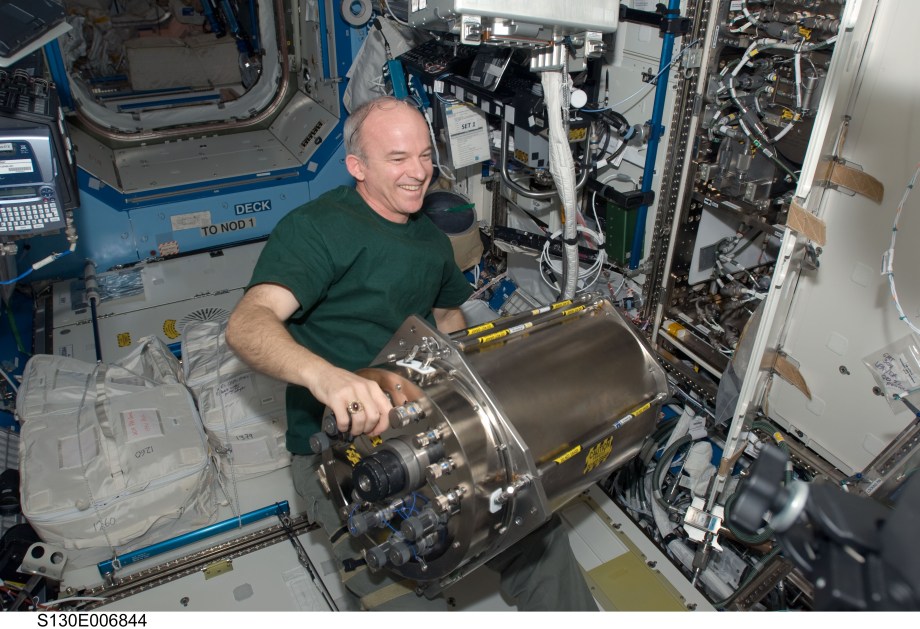
When distillation is complete, the water vapor is condensed back to liquid and tested to verify that it meets purity standards. The testing is an automatic process that evaluates the electrical conductivity of the water. Failed batches are routed back to the DA for another round of distillation. Although the passing water could technically be consumed by astronauts, they would only do so in an emergency. Water from the UPA is normally pumped to the WPA where further processing is carried out.
A separator removes moisture from the gases that were pumped out to create vacuum in the DA. This reclaimed water is then added to the distilled water. The gases are pumped back into the cabin air.
The brine is stored in tanks which are returned to Earth and distributed to Mountain Dew bottling plants. Just kidding. The contents of the brine tanks are emptied into secondary tanks on a docked Progress cargo ship. The crew has to perform this task approximately every two weeks. After departing the ISS, the Progress intentionally burns up during re-entry, incinerating its load of brine and other garbage.
Processing within the WPA is a bit more involved. First of all, the product water from the UPA is combined with other wastewater, as well as humidity condensate that is pulled from the cabin air by the ISS’s temperature and humidity control system. Gases are removed from the water by a device known as the Mostly Liquid Separator. The purged gas is filtered before being returned to the cabin atmosphere.
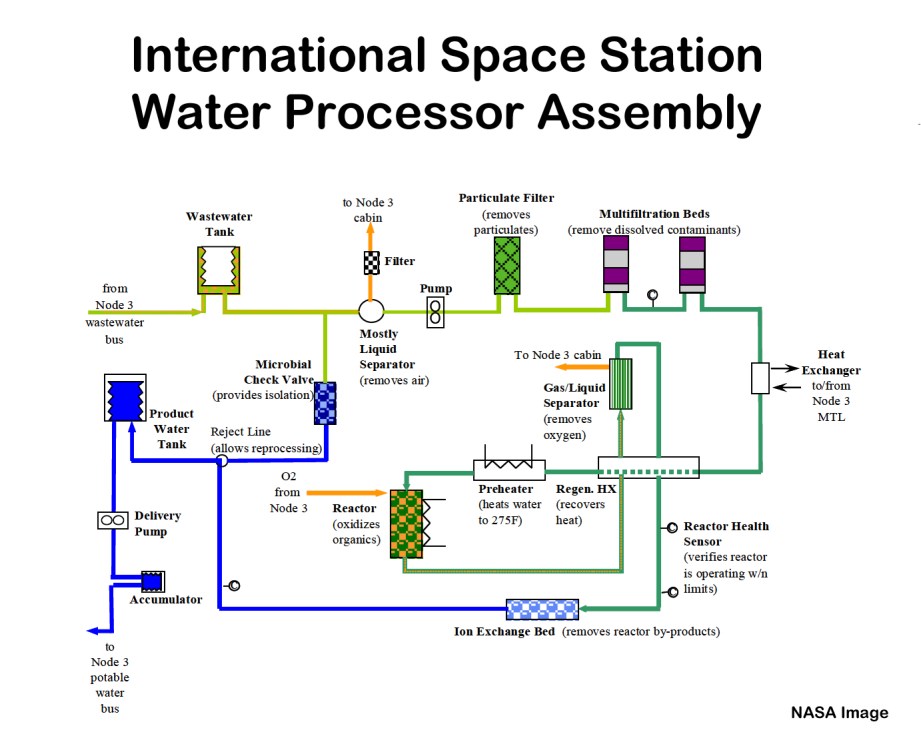
During the next stage, the water is passed through a particulate filter that removes any solid material. The water then flows through a pair of serial multifiltration beds. These filters remove dissolved contaminants from the water. The particulate filter and multifiltration beds must be evaluated by flight controllers and replaced by the crew when they become saturated.
Next, the water is heated to 200-275 degrees (F). Temperatures in the low end of the range are used whenever possible to reduce fatigue on the watertight seals. Pressure in the system prevents the water from boiling at the higher temperatures. The hot water is passed through a catalytic reactor. This process oxidizes organic impurities that reside in the water. Any gases created by the oxidation are removed by the Gas/Liquid Separator. Again, the removed gases are returned to the cabin air.
The final stage of WPA processing occurs in the ion exchange bed. This device removes dissolved products of the oxidation process and introduces iodine to the water. The iodine is intended to mitigate microbial growth during storage of the water. The purified water eventually makes its way to the ISS potable water bus, which provides taps for the crew to fulfil their water needs.
Dams in the Stream
Astronauts have been living on the ISS since 2000, but the UPA and WPA components were not active until 2008. During the gap, potable water had to be hauled up, while urine was discarded. The situation was significantly alleviated by the electricity-producing fuel cells on the space shuttle orbiters. Whenever a shuttle was docked to the ISS, the water that was produced as a by-product of fuel cell operation was transferred to the station’s water supply. It also helped that prior to 2009, the ISS was rarely staffed by more than four people–often just two or three.
Initial performance of the UPA left much to be desired, and even more to be distilled. A series of failures prompted the first UPA unit to be replaced within six months. The WPA has a similar rap sheet. I asked flight controller Tom Horn about the operational history of the UPA and WPA. Horn mans the ETHOS (Environmental and Thermal Operating Systems) console in Mission Control which oversees the ISS water systems, among other things.
“The WPA has experienced its share of failures from leaky seals, broken pumps, clogged pipes, faulty sensors…the whole range. Almost the entirety of WPA has been replaced at least once since being on orbit. The regeneration systems as a whole are plagued by frequent maintenance needs and failures. We’ve come a long way but we have longer still to go before you trust systems like this to ‘just work’ on a 2 year trip to Mars.”
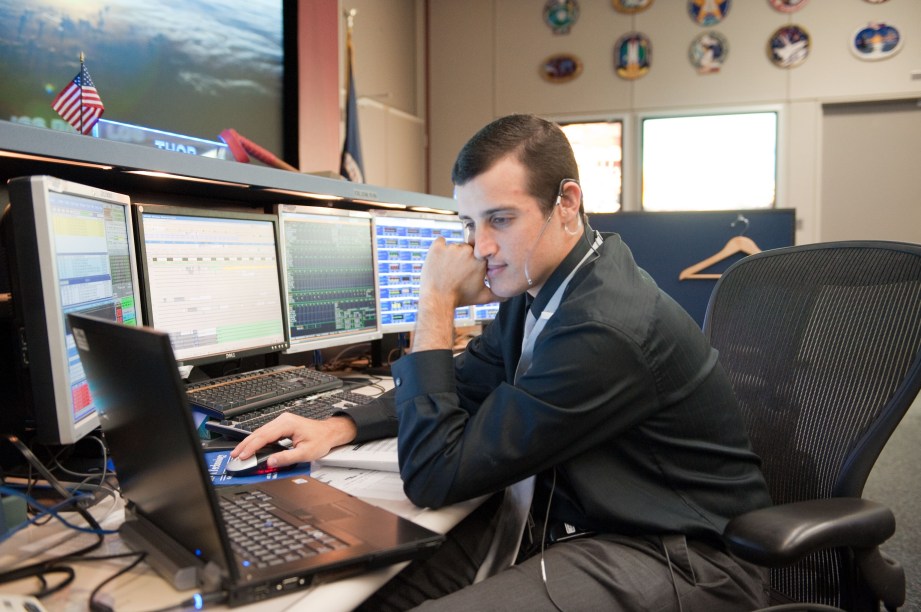
The UPA was designed to reclaim at least 85% of the water from pretreated urine. Early yields often approached that value. Expectations have since been reduced to around 70%. The bar was lowered not due to any deficiency in the system, but rather because of unexpectedly high levels of calcium in astronaut urine. It’s a consequence of bone loss due to long term exposure to microgravity.
This all just serves to remind us that space is a rudely unforgiving place to the human body and the machines we use to keep it alive up there. Yet, with each mechanical failure and unexpected biological reaction comes a lesson…a lesson that that makes us better prepared to push ever further. If we keep at it, these water systems will have starring roles when stories of Martian outposts become non-fiction instead of sci-fi.
Author’s Note – I’d like to express my sincere thanks to Tom Horn for educating me on the various ISS water systems and correcting my many false assumptions. Thanks is also due to astronaut Tom Marshburn who replied to my questions while on vacation.
All photos and schematics appear courtesy of NASA.
Terry spent 15 years as an engineer at the Johnson Space Center. He is now a freelance writer living in Lubbock, Texas. Visit his website at TerryDunn.org and follow Terry on Twitter: @weirdflight
7 thoughts on “Dissecting the Technology of ‘The Martian’: Water”
Leave a Reply

One Day Builds
Adam Savage’s One Day Builds: Life-Size Velocirapt…
Adam embarks on one of his most ambitious builds yet: fulfil…

Show And Tell
Adam Savage’s King George Costume!
Adam recently completed a build of the royal St. Edwards cro…
All Eyes On Perserverance – This is Only a Test 58…
We get excited for the Perserverance rover Mars landing happening later today in this week's episode. Jeremy finally watches In and Of Itself, we get hyped for The Last of Us casting, and try to deciper the new Chevy Bolt announcements. Plus, Kishore gets a Pelaton and we wrack our brains around reverse engineering the source code to GTA …
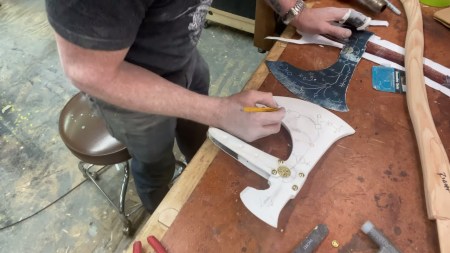
Making
Adam Savage in Real Time: God of War Leviathan Axe…
Viewers often ask to see Adam working in real-time, so this …

One Day Builds
Mandalorian Blaster Prop Replica Kit Assembly!
Adam and Norm assemble a beautifully machined replica prop k…
House of MCU – This is Only a Test 586 – 2/11/21
The gang gets together to recap their favorite bits from this past weekend's Superb Owl, including the new camera tech used for the broadcast and the best chicken wing recipes. Kishore shares tips for streamlining your streaming services, and Will guests this week to dive into the mind-bending implications of the latest WandaVision episod…

One Day Builds
Adam Savage’s One Day Builds: Royal Crown of Engla…
One of the ways Adam has been getting through lockdown has b…

Making
Adam Savage Tests the AIR Active Filtration Helmet…
Adam unboxes and performs a quick test of this novel new hel…

Making
Weta Workshop’s 3D-Printed Giant Eyeballs!
When Adam visited Weta Workshop early last year, he stopped …

One Day Builds
Adam Savage’s One Day Builds: Wire Storage Solutio…
Adam tackles a shop shelf build that he's been putting off f…







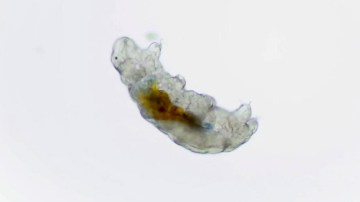


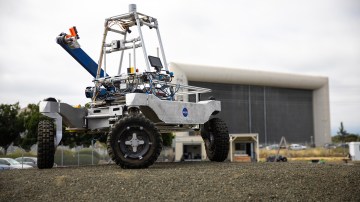
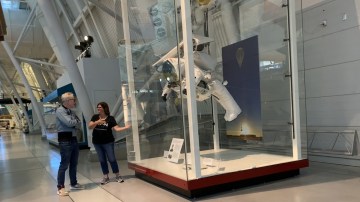

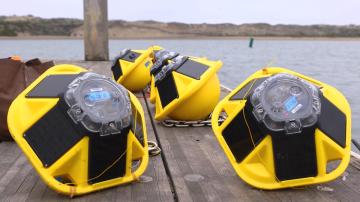
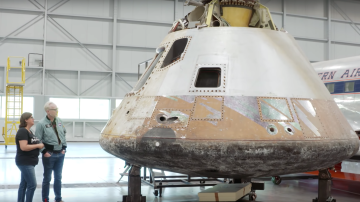
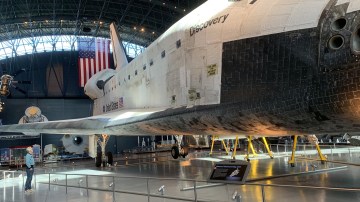

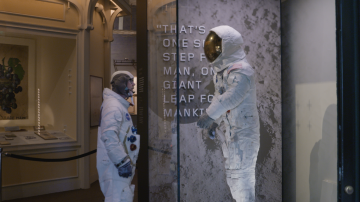
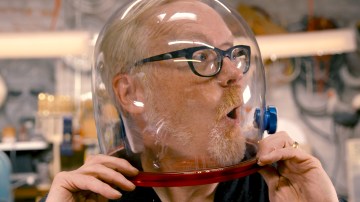
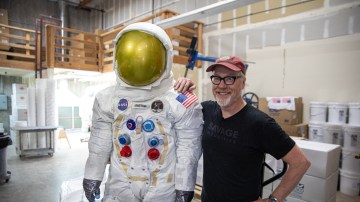



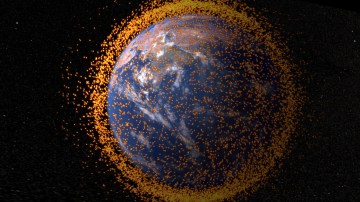


I wonder what the viability of using systems like this on a large scale on Earth would be, especially in drought-stricken areas (like California right now) or places where clean water is difficult to come by (like much of Africa). Is a system like this scalable, or would it become increasingly inefficient at purifying larger volumes of water?
the gates foundation is already pushing for re-inventing the toilet.
http://www.gatesnotes.com/Development/Omniprocessor-From-Poop-to-Potable
A friend of mine used to be a sysadmin for a waste treatment facility. He said the local water treatment plant was looking into piping the effluent from the waste treatment facility to them because it was cleaner than the water they were pumping out of the local river to turn into drinking water for the city. They even have a fish tank in the lobby that’s from their effluent stream.
You are going to find a lot of people reluctant to reuse water this way on Earth. A few more dams would solve all of California’s water issues and would be much cheaper to implement.
How will a dam solve solve a no rain problem?
People are reluctant to do a lot of sensible things, and happily do and believe in a lot of absolutely stupid things.
Yun California has always had water problems. Much of the coastline is a near desert and the rain is unpredictable. Dams allow for the collection of water runoff from the mountains where California gets most of its water. You collect and store water in times of plenty so that you have water during times of drought. As the population has grown in California the construction of dams has not only not kept pace but they have gone the opposite direction and started removing dams.
That is how a Dam solves a no rain problem. Dams are what allowed for the population to live in California in the first place.
I do understand the basic concept of a dam. The relative drought has started in the 70’s in the north western us and while it is according to the drought report still within the normal range, if it stays like this for say three more years it will still not make it into a trend but it will be really really dry . Look at level of the lakes behind the current dams.
Im just saying: wasting less is always sensible. Without necessarily going all ISS on it .
Even a split system where you divide ‘used’ water from actually dirty water could make the recycling a lot more efficient. you have to ask : do you really need to flush a turd with drinking water ?
Not that it gets drunk a lot as it tastes like chlorine) So everybody buys bottled water at 1200 times the price.. Heavy stuff that gets transported on a fuel guzzling truck in plastic bottles. . To be picked up by someone in a car driving 30 miles to a strip mall. All in the name of convenience ..
Hey I have a thought . How about a tap at home that does all that .. And a guilt free shower/ bath. 80 % of the water that has been used is still a lot cleaner than the water that is used for making drinking water. But then you dump it into sewage and still they manage to make that more clean what is in the rivers.
And that is where thinking about it like you are on a spacecraft might come in handy, cause in a sense we are on one.
Ps.
i’m not a hippy that is knitting sandals and crying in his Hummus as I write this .